2015 DODGE CHARGER check oil
[x] Cancel search: check oilPage 540 of 638
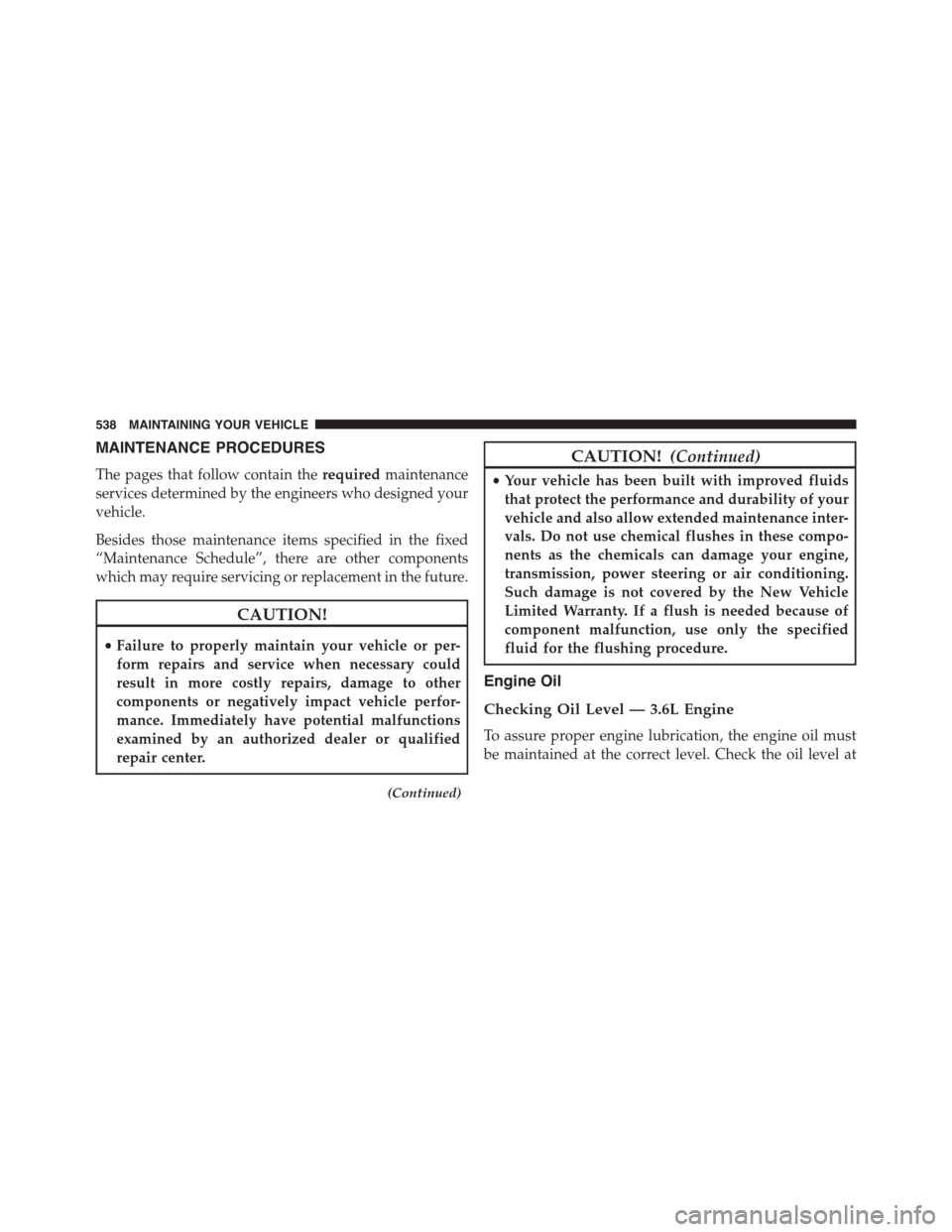
MAINTENANCE PROCEDURES
The pages that follow contain therequiredmaintenance
services determined by the engineers who designed your
vehicle.
Besides those maintenance items specified in the fixed
“Maintenance Schedule”, there are other components
which may require servicing or replacement in the future.
CAUTION!
•Failure to properly maintain your vehicle or per-
form repairs and service when necessary could
result in more costly repairs, damage to other
components or negatively impact vehicle perfor-
mance. Immediately have potential malfunctions
examined by an authorized dealer or qualified
repair center.
(Continued)
CAUTION!(Continued)
•Your vehicle has been built with improved fluids
that protect the performance and durability of your
vehicle and also allow extended maintenance inter-
vals. Do not use chemical flushes in these compo-
nents as the chemicals can damage your engine,
transmission, power steering or air conditioning.
Such damage is not covered by the New Vehicle
Limited Warranty. If a flush is needed because of
component malfunction, use only the specified
fluid for the flushing procedure.
Engine Oil
Checking Oil Level — 3.6L Engine
To assure proper engine lubrication, the engine oil must
be maintained at the correct level. Check the oil level at
538 MAINTAINING YOUR VEHICLE
Page 541 of 638
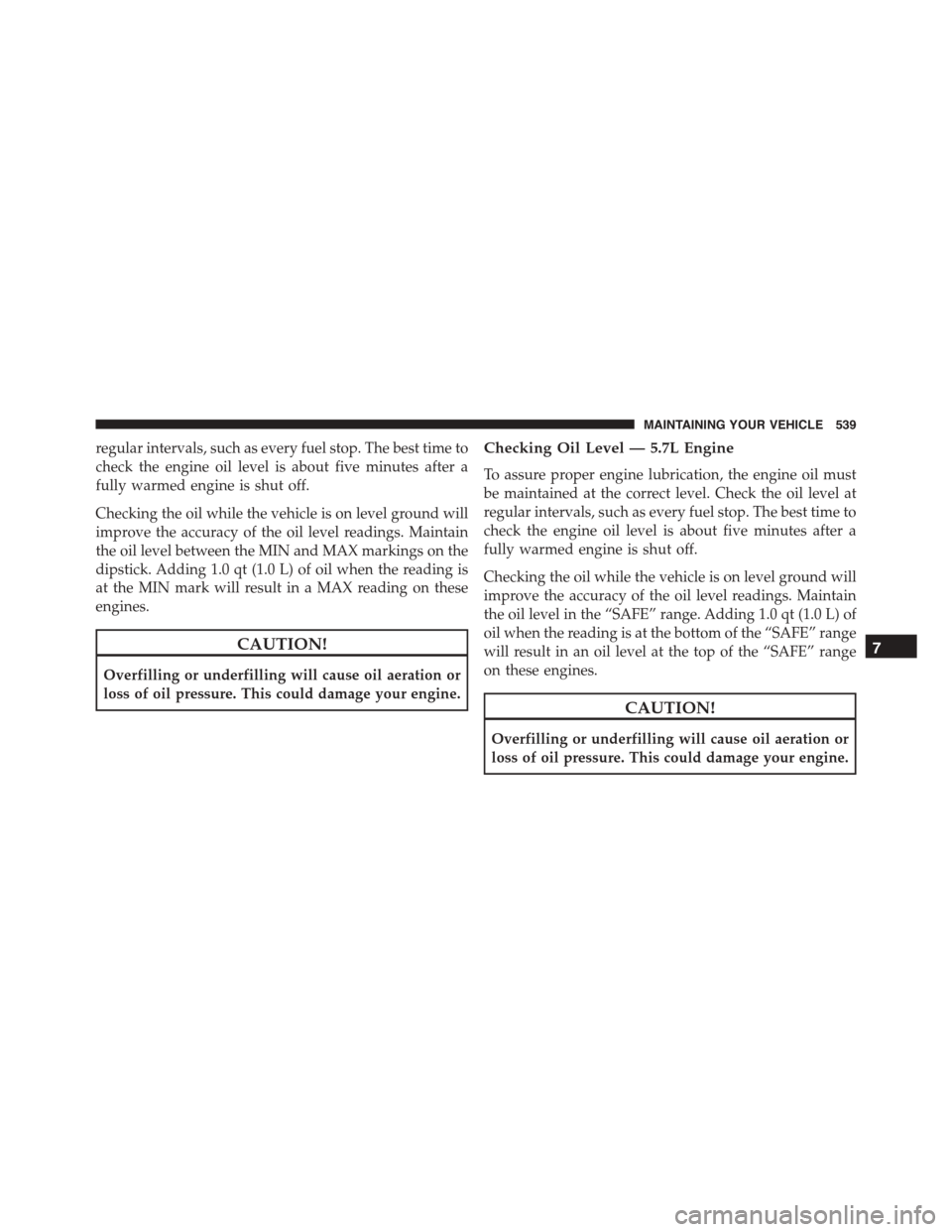
regular intervals, such as every fuel stop. The best time to
check the engine oil level is about five minutes after a
fully warmed engine is shut off.
Checking the oil while the vehicle is on level ground will
improve the accuracy of the oil level readings. Maintain
the oil level between the MIN and MAX markings on the
dipstick. Adding 1.0 qt (1.0 L) of oil when the reading is
at the MIN mark will result in a MAX reading on these
engines.
CAUTION!
Overfilling or underfilling will cause oil aeration or
loss of oil pressure. This could damage your engine.
Checking Oil Level — 5.7L Engine
To assure proper engine lubrication, the engine oil must
be maintained at the correct level. Check the oil level at
regular intervals, such as every fuel stop. The best time to
check the engine oil level is about five minutes after a
fully warmed engine is shut off.
Checking the oil while the vehicle is on level ground will
improve the accuracy of the oil level readings. Maintain
the oil level in the “SAFE” range. Adding 1.0 qt (1.0 L) of
oil when the reading is at the bottom of the “SAFE” range
will result in an oil level at the top of the “SAFE” range
on these engines.
CAUTION!
Overfilling or underfilling will cause oil aeration or
loss of oil pressure. This could damage your engine.
7
MAINTAINING YOUR VEHICLE 539
Page 551 of 638
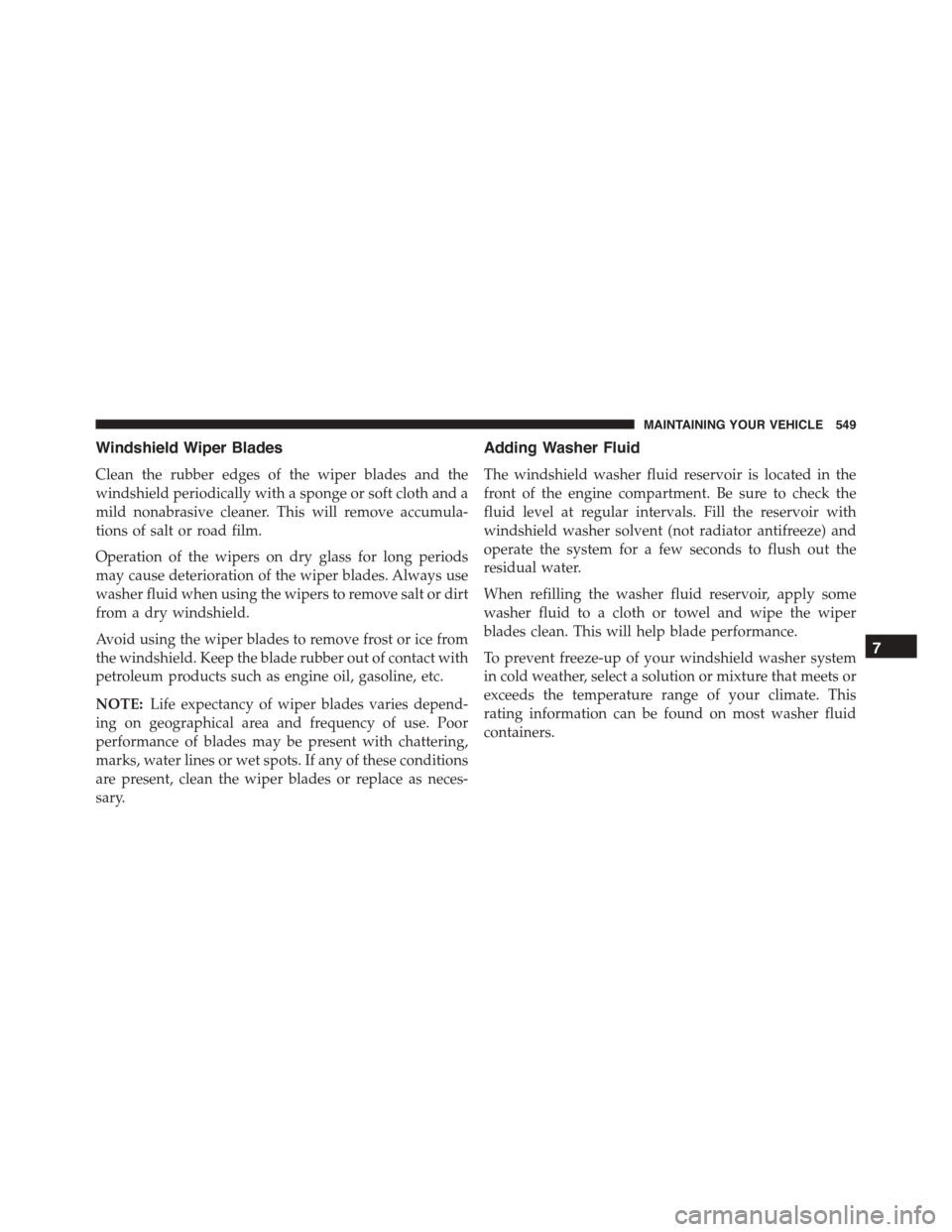
Windshield Wiper Blades
Clean the rubber edges of the wiper blades and the
windshield periodically with a sponge or soft cloth and a
mild nonabrasive cleaner. This will remove accumula-
tions of salt or road film.
Operation of the wipers on dry glass for long periods
may cause deterioration of the wiper blades. Always use
washer fluid when using the wipers to remove salt or dirt
from a dry windshield.
Avoid using the wiper blades to remove frost or ice from
the windshield. Keep the blade rubber out of contact with
petroleum products such as engine oil, gasoline, etc.
NOTE:Life expectancy of wiper blades varies depend-
ing on geographical area and frequency of use. Poor
performance of blades may be present with chattering,
marks, water lines or wet spots. If any of these conditions
are present, clean the wiper blades or replace as neces-
sary.
Adding Washer Fluid
The windshield washer fluid reservoir is located in the
front of the engine compartment. Be sure to check the
fluid level at regular intervals. Fill the reservoir with
windshield washer solvent (not radiator antifreeze) and
operate the system for a few seconds to flush out the
residual water.
When refilling the washer fluid reservoir, apply some
washer fluid to a cloth or towel and wipe the wiper
blades clean. This will help blade performance.
To prevent freeze-up of your windshield washer system
in cold weather, select a solution or mixture that meets or
exceeds the temperature range of your climate. This
rating information can be found on most washer fluid
containers.
7
MAINTAINING YOUR VEHICLE 549
Page 566 of 638
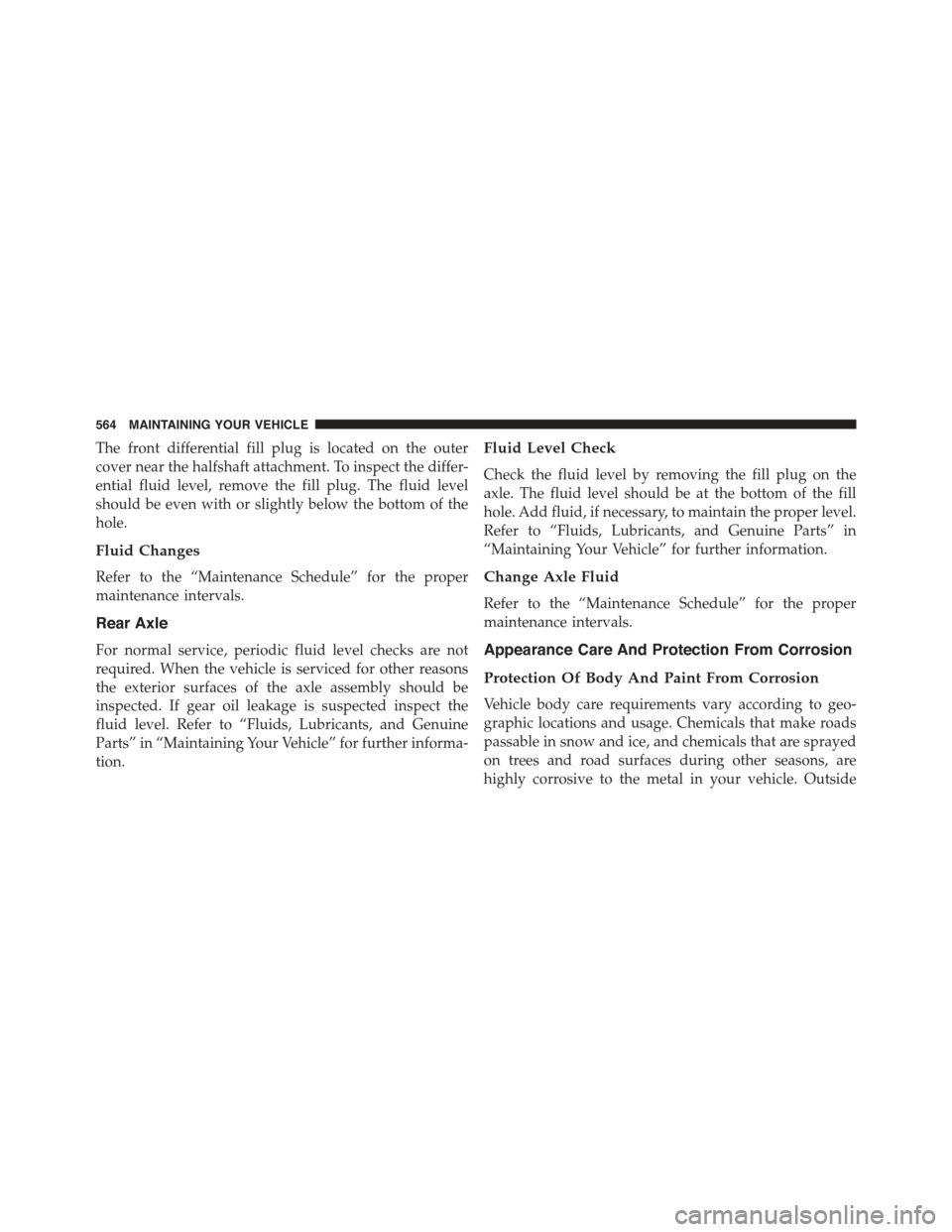
The front differential fill plug is located on the outer
cover near the halfshaft attachment. To inspect the differ-
ential fluid level, remove the fill plug. The fluid level
should be even with or slightly below the bottom of the
hole.
Fluid Changes
Refer to the “Maintenance Schedule” for the proper
maintenance intervals.
Rear Axle
For normal service, periodic fluid level checks are not
required. When the vehicle is serviced for other reasons
the exterior surfaces of the axle assembly should be
inspected. If gear oil leakage is suspected inspect the
fluid level. Refer to “Fluids, Lubricants, and Genuine
Parts” in “Maintaining Your Vehicle” for further informa-
tion.
Fluid Level Check
Check the fluid level by removing the fill plug on the
axle. The fluid level should be at the bottom of the fill
hole. Add fluid, if necessary, to maintain the proper level.
Refer to “Fluids, Lubricants, and Genuine Parts” in
“Maintaining Your Vehicle” for further information.
Change Axle Fluid
Refer to the “Maintenance Schedule” for the proper
maintenance intervals.
Appearance Care And Protection From Corrosion
Protection Of Body And Paint From Corrosion
Vehicle body care requirements vary according to geo-
graphic locations and usage. Chemicals that make roads
passable in snow and ice, and chemicals that are sprayed
on trees and road surfaces during other seasons, are
highly corrosive to the metal in your vehicle. Outside
564 MAINTAINING YOUR VEHICLE
Page 599 of 638
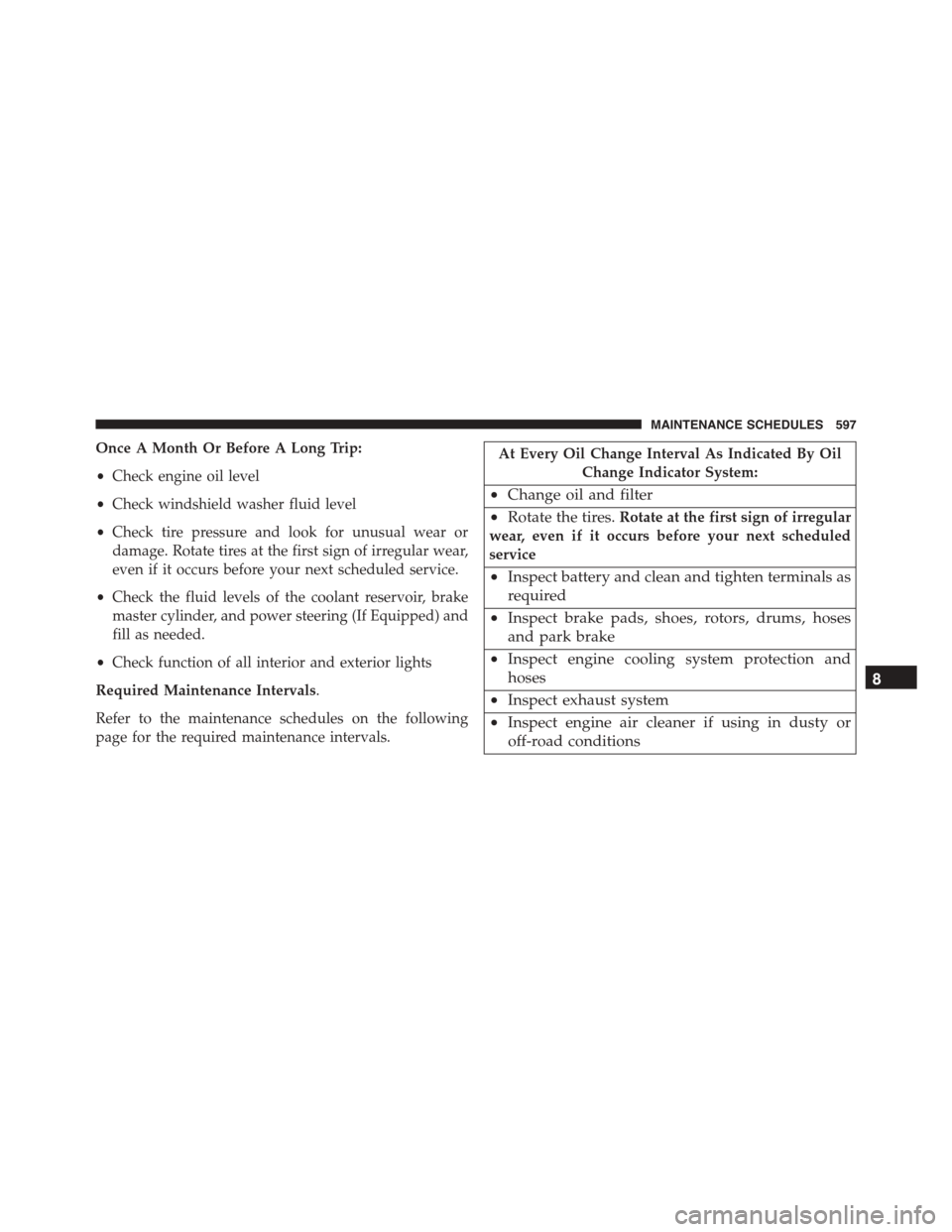
Once A Month Or Before A Long Trip:
•Check engine oil level
•Check windshield washer fluid level
•Check tire pressure and look for unusual wear or
damage. Rotate tires at the first sign of irregular wear,
even if it occurs before your next scheduled service.
•Check the fluid levels of the coolant reservoir, brake
master cylinder, and power steering (If Equipped) and
fill as needed.
•Check function of all interior and exterior lights
Required Maintenance Intervals.
Refer to the maintenance schedules on the following
page for the required maintenance intervals.
At Every Oil Change Interval As Indicated By Oil
Change Indicator System:
•Change oil and filter
•Rotate the tires.Rotate at the first sign of irregular
wear, even if it occurs before your next scheduled
service
•Inspect battery and clean and tighten terminals as
required
•Inspect brake pads, shoes, rotors, drums, hoses
and park brake
•Inspect engine cooling system protection and
hoses
•Inspect exhaust system
•Inspect engine air cleaner if using in dusty or
off-road conditions
8
MAINTENANCE SCHEDULES 597
Page 618 of 638
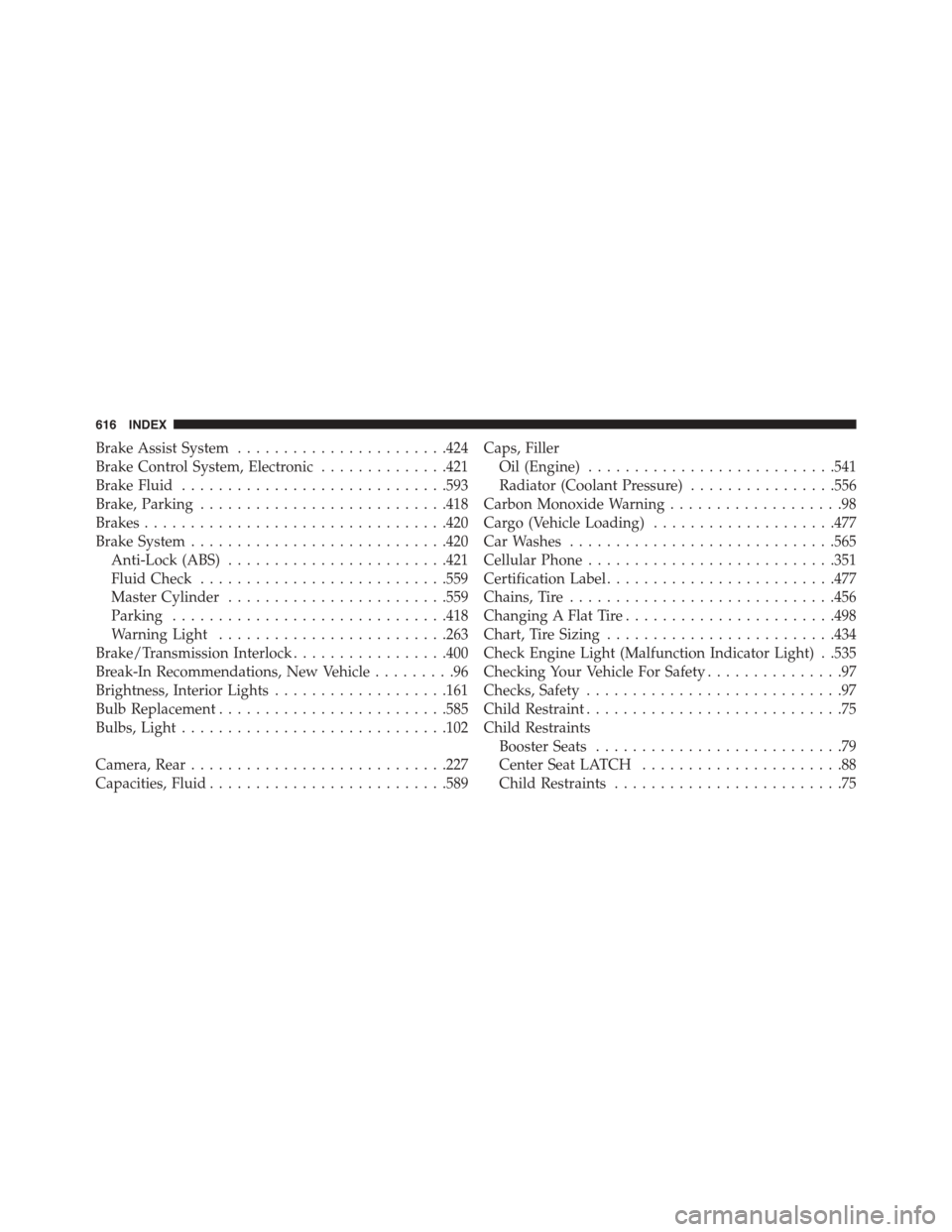
Brake Assist System.......................424
Brake Control System, Electronic..............421
Brake Fluid.............................593
Brake, Parking...........................418
Brakes.................................420
Brake System............................420
Anti-Lock (ABS)........................421
Fluid Check...........................559
Master Cylinder........................559
Parking..............................418
Warning Light.........................263
Brake/Transmission Interlock.................400
Break-In Recommendations, New Vehicle.........96
Brightness, Interior Lights...................161
Bulb Replacement.........................585
Bulbs, Light.............................102
Camera, Rear............................227
Capacities, Fluid..........................589
Caps, Filler
Oil (Engine)...........................541
Radiator (Coolant Pressure)................556
Carbon Monoxide Warning...................98
Cargo (Vehicle Loading)....................477
Car Washes.............................565
Cellular Phone...........................351
Certification Label.........................477
Chains, Tire.............................456
Changing A Flat Tire.......................498
Chart, Tire Sizing.........................434
Check Engine Light (Malfunction Indicator Light) . .535
Checking Your Vehicle For Safety...............97
Checks, Safety............................97
Child Restraint............................75
Child Restraints
Booster Seats...........................79
Center Seat LATCH......................88
Child Restraints.........................75
616 INDEX
Page 621 of 638

Brake Assist System.....................424
Traction Control System...................423
Electronic Power Distribution Center (Fuses)......572
Electronic Speed Control (Cruise Control)........174
Electronic Stability Control (ESC)..............425
Emergency Deck Lid Release..................45
Emergency, In Case of
Freeing Vehicle When Stuck................521
Jacking...............................498
Jump Starting..........................517
Overheating...........................495
Towing..............................526
Emergency Trunk Release....................45
Emission Control System Maintenance..........535
Engine.................................534
Air Cleaner...........................543
Block Heater..........................398
Break-In Recommendations.................96
Checking Oil Level......................538
Compartment..........................533
Compartment Identification................533
Coolant (Antifreeze).....................553
Cooling..............................552
Exhaust Gas Caution.....................98
Fails to Start...........................396
Flooded, Starting.......................396
Fuel Requirements......................464
Jump Starting..........................517
Oil . . . . . . . . . . . . . . . . . . . . . . . . . . . . . . . . ..538
Oil Filler Cap..........................541
Oil Selection...........................540
Oil Synthetic..........................542
Overheating...........................495
Starting..............................393
Temperature Gauge......................263
Engine Oil Viscosity.......................541
Engine Oil Viscosity Chart...................541
EnhancedAccident Response Feature............70
10
INDEX 619
Page 622 of 638
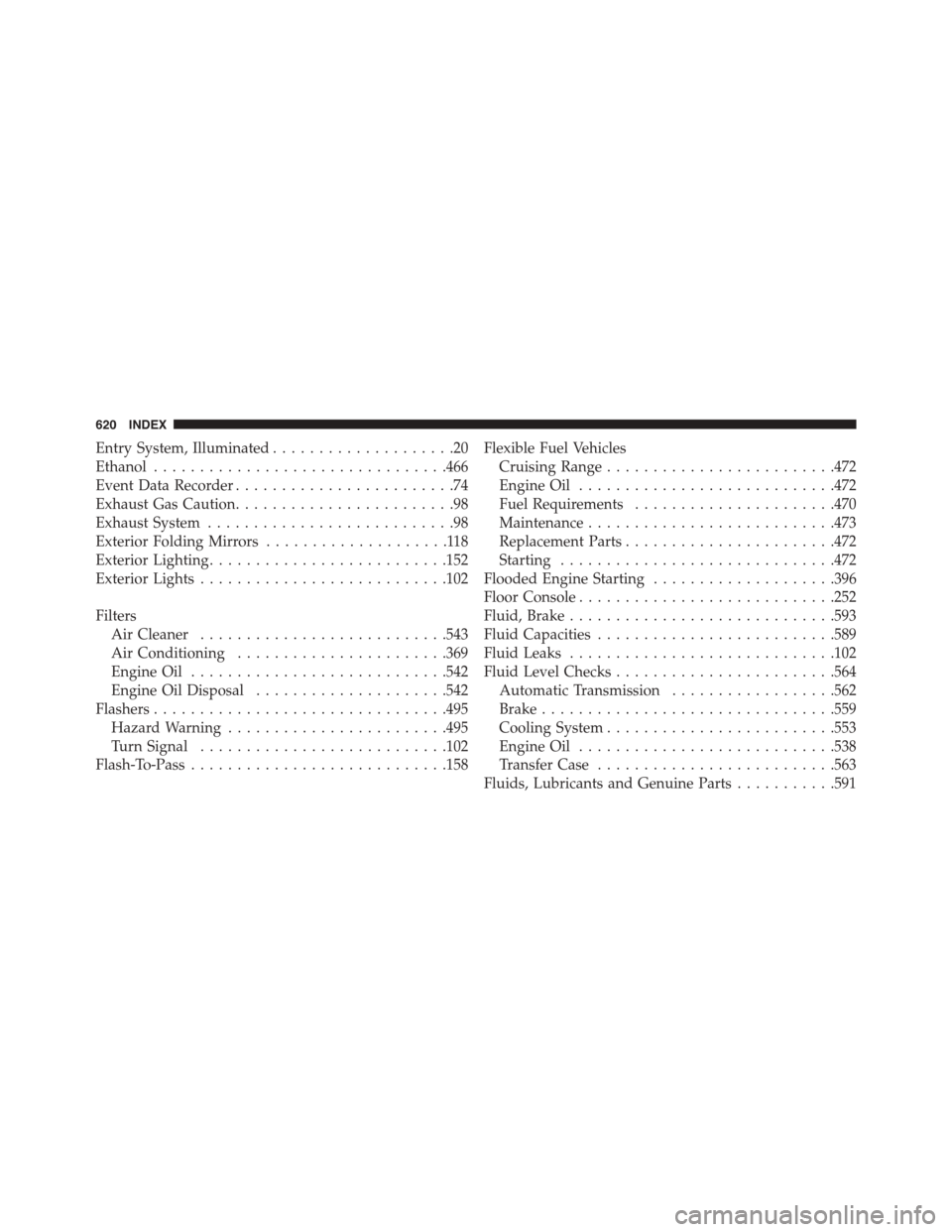
Entry System, Illuminated....................20
Ethanol................................466
Event Data Recorder........................74
Exhaust Gas Caution........................98
Exhaust System...........................98
Exterior Folding Mirrors....................118
Exterior Lighting..........................152
Exterior Lights...........................102
Filters
Air Cleaner...........................543
Air Conditioning.......................369
Engine Oil............................542
Engine Oil Disposal.....................542
Flashers................................495
Hazard Warning........................495
Turn Signal...........................102
Flash-To-Pass............................158
Flexible Fuel Vehicles
Cruising Range.........................472
Engine Oil............................472
Fuel Requirements......................470
Maintenance...........................473
Replacement Parts.......................472
Starting..............................472
Flooded Engine Starting....................396
Floor Console............................252
Fluid, Brake.............................593
Fluid Capacities..........................589
Fluid Leaks.............................102
Fluid Level Checks........................564
Automatic Transmission..................562
Brake................................559
Cooling System.........................553
Engine Oil............................538
Transfer Case..........................563
Fluids, Lubricants and Genuine Parts...........591
620 INDEX